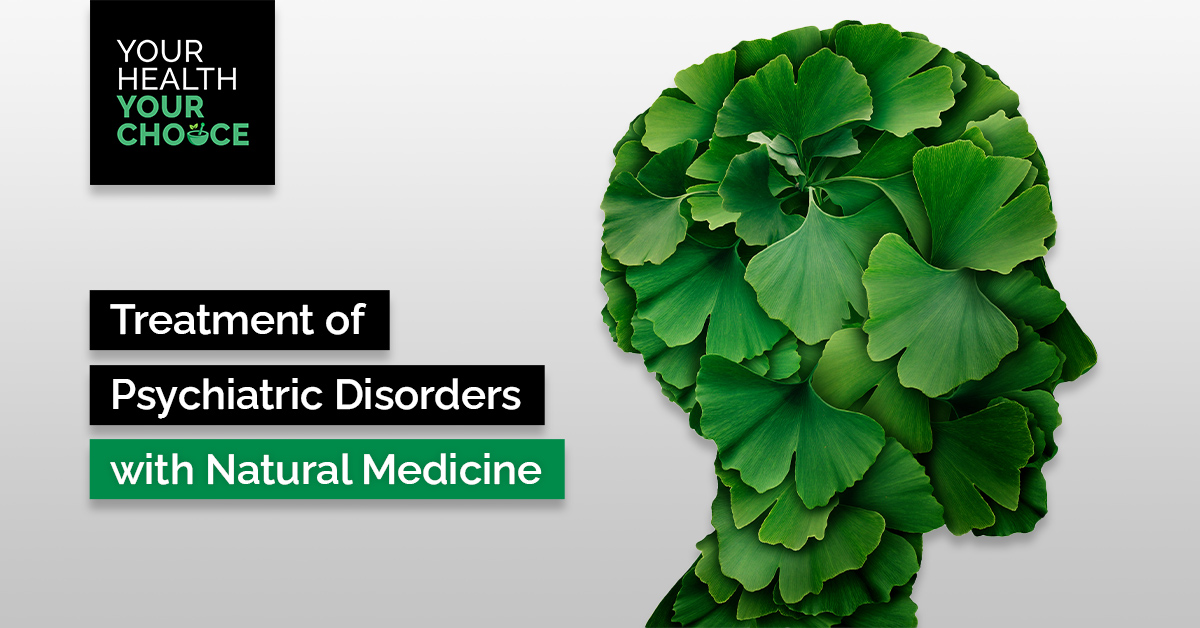New clinician guidelines for the treatment of psychiatric disorders with natural medicine options

During the Covid-19 pandemic there was a marked increase in Australians seeking support from health practitioners for mental health related issues.
The therapeutic use of nutrient-based ‘nutraceuticals’ and plant-based ‘phytoceuticals’ for the treatment of mental disorders is common. However, despite recent research progress, there have not been any updated global clinical guidelines since 2015 to help guide clinical decision-making.
To address this, the World Federation of Societies of Biological Psychiatry (WFSBP) and the Canadian Network for Mood and Anxiety Disorders (CANMAT) convened an international taskforce involving 31 leading academics and clinicians from 15 countries, between 2019 and 2021. The taskforce included leading experts from Australian universities and research institutes.
Evidence-informed approach to assist clinicians
The new guidelines are aimed at providing an evidence-informed approach to assist psychiatric/medical, and health professional practice clinicians globally in making decisions around the use of natural medicine alternatives and adjunctive therapeutic options for the management of major psychiatric disorders.
The guidelines also provide detail on safety and tolerability, as well as clinical advice regarding prescription (e.g. indications, dosage) and consideration for use in specialised groups.
Findings
The taskforce noted that where supportive evidence exists, use of the nutraceuticals and phytoceuticals identified in the guidelines be primarily recommended adjunctively (i.e. as supportive treatments used together with a primary treatment) within a standard medical/health professional care model, especially in cases of more severe mental illness.
With respect to safety and tolerability, all interventions were deemed to have varying acceptable levels of safety and tolerability for low-risk over-the-counter use in most circumstances.
The following key was used to rate the nutraceuticals/ phytoceuticals in the findings: Grade A evidence (recommended+++); positive directionality (provisionally recommended++); or varying levels of support (weakly recommended+).
The following key was used to present whether an intervention for a particular condition was ‘Recommended’ (+++), ‘Provisionally Recommended’ (++), ‘Weakly Recommended’ (+), ‘Not Currently Recommended’ (+/−), or ‘Not Recommended’ (−).
Unipolar depression (major depressive disorder)
Nutraceuticals:
In the treatment of unipolar depression (major depressive disorder), amongst nutraceuticals with Grade A evidence, positive directionality and varying levels of support was reported for:
– adjunctive omega-3 fatty acids (+++)
– vitamin D (+)
– adjunctive probiotics (++)
– adjunctive zinc (++)
– methylfolate (+), and
– adjunctive s-adenosyl methionine (SAMe) (+)
– Monotherapy omega-3 (+/−), folic acid (−), vitamin C (−), tryptophan (+/−), creatine (+/−), inositol (−), magnesium (−), and n-acetyl cysteine (NAC) (+/−) and SAMe (+/−) were not supported for use in unipolar depression.
Phytoceuticals:
Phytoceuticals with supporting Grade A evidence and positive directionality for unipolar depression included:
– St John’s wort (Hypericum perforatum) (+++)
– Saffron (Crocus sativus) (++)
– Curcumin (from Turmeric, Curcuma longa) (++)
– Lavender (Lavandula spp) (+)
Rhodiola (Rhodiola rosea) was not supported for use in mood disorders, based on the available research evidence.
Anxiety disorders:
Phytoceuticals:
The following herbs were modestly supported in the treatment of anxiety disorders:
– Ashwagandha (Withania somnifera) (++)
– Galphimia (Galphimia glauca) (+)
– Lavender (Lavandula spp) (++)
Kava (Piper methysticum) (−) and Chamomile (Matricaria spp) (+/−) were not recommended for generalised anxiety disorder.
Bipolar disorder
For bipolar depression, omega-3 had weak support (+).
N-acetyl cysteine (NAC) was not currently recommended (+/−).
OCD-related disorders
NAC was weakly recommended (+) in the treatment of OCD-related disorders.
No other nutraceutical had sufficient evidence in any anxiety-related disorder.
Schizophrenia
Vitamin D (+), NAC (++) and methylfolate (++) were recommended to varying degrees in the treatment of the negative symptoms in schizophrenia.
Omega-3 fatty acids were not recommended, although evidence suggests a role for prevention of transition to psychosis in high-risk youth, with potential pre-existing fatty acid deficiency.
Phytoceuticals:
Ginkgo (Ginkgo biloba) was weakly supported in the adjunctive treatment of negative symptoms of schizophrenia (+).
ADHD:
Nutraceuticals:
Micronutrients (+) and vitamin D (+) were weakly supported in the treatment of ADHD.
Omega-3 (+/−) and omega-9 fatty acids (−), acetyl L carnitine (−), and zinc (+/−) were not supported.
Phytoceuticals:
Ginkgo was not supported in the treatment of ADHD (+/−).
Are the guidelines definitive?
The WFSBP/ CANMAT guidelines are based on the most current peer-reviewed research literature on nutrient and plant-based options that have been investigated to assist mental health disorders, within the parameters of the ‘evidence-based medicine’ (EBM) paradigm. While providing a useful resource, it is far from definitive.
Development of the guidelines excluded a large body of data, including traditional knowledge systems, individual trials and clinical case series. Although not meeting the parameters of the guidelines, such evidence still embodies important clinically-informed knowledge that is used by clinicians in daily practice to help provide individualised treatments for patients.
Enough research has not yet been conducted into many plant medicines that have nonetheless proven useful when prescribed by experienced and skilled practitioners in daily practice, based on specific indications developed over millennia of clinical use across different cultures.
This is why the authors of the guidelines acknowledge:
“it is recognised that an absence of data does not imply lack of efficacy.”
Limitations of EBM botanical medicine research:
One of the limitations of the EBM paradigm is that it is highly resource-intensive to conduct trials that examine subsets of people that are most likely to benefit from a particular plant medicine, based on indicators mapped by traditional knowledge systems. This is compounded by the fact that research into complementary medicines has a much smaller funding pool than pharmaceutical research.
For a clinical herbalist/ naturopath, the key question is ‘which plants are best suited to which people with a health condition?’
Traditionally, plant medicines are prescribed for a disorder within the context of the person experiencing the disorder. Traditional systems such as Traditional Western Herbal Medicine, Ayurveda and Traditional Chinese Medicine (TCM) have this principle of holism embedded within their philosophies and clinical frameworks. It is foundational to Homeopathy.
In practice, it means that three different people with the same medical disorder may be prescribed different plant medicines based on the different and unique ways they experience the disorder, alongside other symptoms unique to the individual.
The problem is that research trials within the EBM paradigm usually test whether or not a plant medicine assists a defined medical condition as the prime focus – without taking into account which sub-group(s) of trial participants are most likely to be suited to the plant medicine based on traditional indications. Yet the latter is what is of most use to a clinician.
This ‘condition’ over ‘whole person’ approach means that positive effects experienced by a subset(s) of trial participants becomes buried as the results are statistically ‘averaged out’ at the end of the trial. Trial designs mostly do not cater for sub-variance.
For example, a trial investigating the effectiveness of the popular herb Valerian for sleep disorders may conclude little evidence of effectiveness – whereas a subset of the trial participants for whom Valerian was well-indicated according to established traditional indicators may have experienced good improvement. Such positive effects are often statistically nullified by the majority who do not experience improvement.
All such a trial shows is that Valerian does not help everyone with a sleep disorder (which is already known), but not that it isn’t effective for some people whose particular kind of sleep disorder is well-indicated for Valerian.
Integrating such factors in trial designs would take research into botanical medicines to a the next level and make their findings more clinically useful.
Reference:
Sarris J, Ravindrand A, Yathame LN et al. Clinician guidelines for the treatment of psychiatric disorders with nutraceuticals and phytoceuticals: The World Federation of Societies of Biological Psychiatry (WFSBP) and Canadian Network for Mood and Anxiety Treatments (CANMAT) Taskforce. The World Journal of Biological Psychiatry. 2022, Ahead-of-Print, 1-32. https://doi.org/10.1080/15622975.2021.2013041. https://www.tandfonline.com/doi/epub/10.1080/15622975.2021.2013041?needAccess=true
« Return to News & Features
